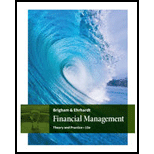
a)
To discuss: Meaning of business risk, capital structure and financial risk.
a)
Explanation of Solution
Capital structure is the combination of debt and equity. Through capital structure it is decided that how much leverage ratio has to be maintained and company decides which sources it will get money and how much volume.
Business risk refers possibility of occurrence of loss due to changes in government policy, taste and preferences of customers that will leads to affect the factors like sales volume, sale price and sales per unit.
Financial risk is the risk where various types of risks associated with this like default risk, in which company sold out item in credit to customer, if customer default in payment or increased the time limit of payment of his cash which ultimately increase the financial risk.
Financial risk might arise due to foreign investment wherever the possibility of risk is higher.
b)
To discuss: Meaning of operating, financial leverages and break-even point.
b)
Explanation of Solution
Operating leverage: It is nothing the degree of change in operating income for percentage change in sales. It is nothing but the ratio of contribution to operating income.
Financial leverage: It is nothing the degree of change in total debt to shareholder’s equity.
Break-even point: It is point where, company has no profit no loss. At break-even point all fixed costs are recovered. It is calculated by using the formula,
c)
To discuss: Reserve borrowing capacity.
c)
Explanation of Solution
It is the capability that company maintain or reserve for future borrowings at the time of good investment arises. Banks are needed to keep cash for uncertain liability and likely the company maintains a reserve borrowing capability to satisfy sensible investment or uncertain liability arises.
Want to see more full solutions like this?
Chapter 15 Solutions
Cengagenow, 1 Term (6 Months) Printed Access Card For Brigham/ehrhardt's Financial Management: Theory & Practice, 15th